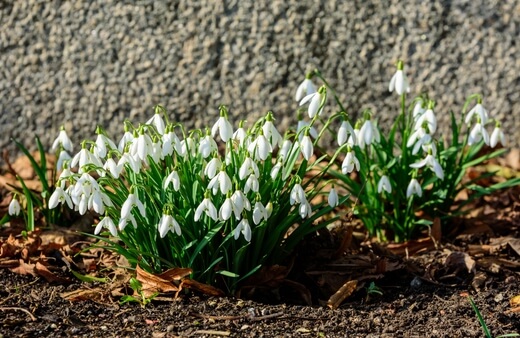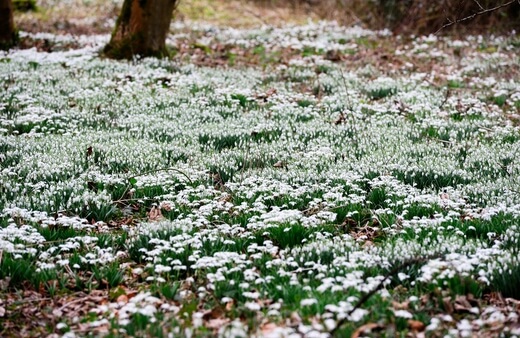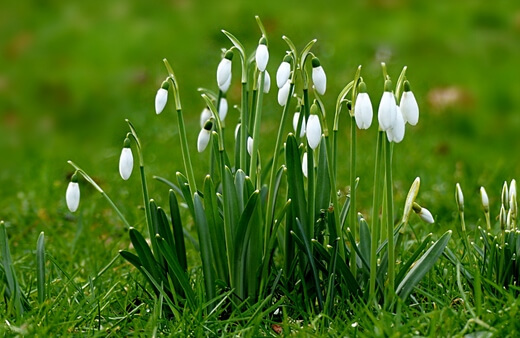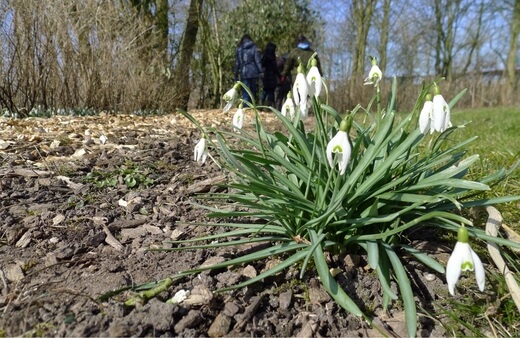Snowdrops are a wonderful challenge for Australian gardeners and require a period of winter cold in order to flower in spring. Providing those conditions anywhere other than cooler southern regions is, honestly, quite a challenge, but one that many collectors still manage to rise to.
If you’ve ever thought about growing these iconic northern hemisphere forest floor plants at home, it’s worth it for the joy of their incredibly delicate and drooping flowers, which pass fleetingly in early spring.
More...

Family: | Amaryllidaceae |
|---|---|
Genus: | Galanthus |
Species: | Various |
Common Names: | Snowdrops |
Location: | Outdoor |
Type: | Perennial bulb |
Growth: | 5-20cm tall |
Sun requirements: | Part shade |
Foliage Colour: | Green |
Flower Colour: | White, some with green tips |
Flowering: | Late winter, early spring |
Fruit: | None |
Maintenance level: | Low |
Poisonous for pets: |
What are Snowdrops?
Snowdrops are a small group of plants in the genus Galanthus, which contains 20 defined species, but hundreds of subtly varied cultivars. For collectors, or Galanthophiles, snowdrops are a way of life, providing both challenges and kudos for the most successful growers.
Breeding your own snowdrops is perhaps a subject for a future article as establishing a clear and reliable variety will take several generations of plants, each grown for seed until the cultivar is reliable enough to propagate from bulbs.
In terms of their anatomy, snowdrops are really quite simple, flowering from small bulbs, which send up fine grassy leaves and either a single or double flowering stem depending on the species.
As snowdrops mature in the ground, or in pots, their bulbs duplicate, providing swathes of snowdrops in cool shaded parts of southern Australian gardens. In Northern Australia, it is virtually impossible to grow them without temperature-controlled habitats or shade houses.
Natural Habitat of Galanthus
Snowdrops are native to cooler regions of Europe and Asia but have naturalised all over the world, likely due to a Roman obsession with the plant during the height of their empire.
The spread of these plants in botanical circles has led to world-famous snowdrop landscapes, bursting into life in spring, and often coinciding with the end of winter and beginning of meteorological spring.
Replicating their natural habitat at home in Australia requires a cool, ventilated space, where winter temperatures drop to freezing or lower (temperatures below 5°C have reportedly worked for some growers).
How to Grow Snowdrops in Australia
When it comes to actually growing them, snowdrops, if you have the right conditions, are incredibly simple to grow. Once the bulbs are in, they will thrive for years to come, cope with summer drought, and are dormant for the majority of the year.

Best Conditions for Planting Snowdrops
Keeping them happy out of their flowering season is simply about reducing flood risks, avoiding boggy conditions, and protecting flowering plants from any baking heat during spring.
Soil and Drainage
Snowdrops need loose, moisture-retentive soil that doesn’t get too damp. They can be grown in pots filled with a mix of compost and grit, or in any soil that allows water to flow through, with a good balance of organic materials.
In sandy gardens, plant snowdrops in pots, or enrich parts of the garden with plenty of soil improver and compost before planting. In clay soils, add copious amounts of grit, compost, and any drainage improving soil additives you can, as they will rarely flower happily on heavy clay.
Sun and Shade
Snowdrops need shade. Not completely, but when they are flowering in spring, they prefer to do so under the canopy of trees, or in the shade of shrubs. 4-5 hours of direct light per day is enough for them.
In very warm parts of Australia, it is still possible to grow snowdrops, but they will need to be sited in a shade house, with ventilation and slatted sunscreens to reduce the temperature.
Temperature and Climate
Snowdrops, ideally, need to be exposed to temperatures below -5°C over winter to flower successfully in the following year. For northern climates, this isn’t possible, but sheltering snowdrops from winter sun, and even storing bulbs in the fridge can help to trigger new growth for serious collectors.
Water Requirements
Snowdrops don’t really need watering unless there is a spring drought. They die back in early summer and stay dormant in the ground until late winter when they push their foliage above ground.
When to Plant Galanthus
Plant snowdrop bulbs in early autumn, allowing them time to settle into cooling, but still slightly warm soil. Lower winter temperatures and darker conditions will naturally trigger spring flowering, and fresh bulbs don’t need feeding, making them a very easy plant to start.
How to Propagate Snowdrops
Snowdrops are best grown from bulbs, which will ensure they are an exact match of their parent, but for avid collectors the joy of growing snowdrops from their (admittedly) challenging seeds, is all part of the fun.

Propagating Snowdrops from Seeds
Snowdrop seeds, by the time they ripen in the swollen pod that develops after a flower, are packed with already germinating seeds. You will very rarely be able to buy them from nurseries or garden centres, and should instead find fresh seeds.
To propagate snowdrop seeds, you will need to harvest them. The best time to do this is as soon as the pod splits open, revealing tiny seeds with little white tails, ready to send down roots.
These seeds can be planted in any good compost with a thin layer of grit. They will take about a year to develop bulbs, and usually flower in their second year.
Propagating Galanthus by Division
For those of you with existing snowdrops, either in pots or the ground, diving them is by far the easiest way to create new swathes of snowdrops.
For pots and bulbs in the ground, the procedure is identical:
- Dig up, or tip out, a clump of snowdrops (20cm clumps work best as they will reestablish and refill their space quite quickly).
- Split it in half, pulling firmly the bulb cluster.
- Replant into the same potting mix or soil type they were growing in before.
- That’s it, two new clumps of snowdrops, which will flower next spring.
How to Care for Snowdrops
As your snowdrops develop, they remain as easygoing as they were when they were planted. If you’ve got the right conditions, mulch, fertiliser, and winter care are something to ignore entirely.
If you’re in a slightly more challenging, warmer setting then follow the guide below for adapting snowdrop care to warm climates or sandy soils.

Mulch and feed
On sandy soils, compost will eventually become humus, which will eventually become completely bare of nutrients. If you do have a sandy garden, snowdrops, while largely self-feeding bulbs, do benefit from a liquid bulb feed, or an annual 1” mulch of partly rotted leaf litter, which worms will work into the soil to maintain moisture and nutrients.
Repotting
Wherever you live, snowdrops need repotting when they start to grow near the edge of a pot. Unlike other perennial bulbs, they have quite a long lifespan, so will fill a container without hollowing in the middle.
To repot snowdrops, simply tip the entire pot out in late summer or autumn when all the foliage has died back, and replant them at the same depth in several new pots.
Winter Care and Saving Bulbs
In warm regions, it's worth digging up your snowdrops, drying their bulbs off and storing them in a cool dry garage or shed through summer, autumn, and winter. If they can stay cool for most of the year, and then be exposed to warming spring temperatures, they will often flower without the need for frost exposure.
The same procedure works for saving bulbs or diving clumps in summer.
Common Snowdrop Pests and Diseases
Squirrels and rodents are the only common pest on snowdrops. Despite their high toxicity, they will dig up and eat them if they are desperate in autumn, especially when they are newly planted. To avoid this, cover the planting patch or pot with chicken wire so they can’t dig into the soil as easily.
In twenty-something years of growing snowdrops I’ve never seen anything other than mice eat snowdrop bulbs, and haven’t found a slug or aphid anywhere near them, so can confidently say that you don’t need to worry about any insect pests on these tough little bulbs once they get going.
One common fungal infection that does affect snowdrops in some countries is stagonspora, which manifests as tiny red spots that scatter up the length of a leaf. It begins on the bulb, so by the time it is visible on leaves it's too late for that plant.
The only way to stem the spread is to dig up the affected bulbs and dispose of them, either by burning or in general waste.
Snowdrops Frequently Asked Questions

Do snowdrops flower in winter?
Snowdrops flower just after the height of winter, which triggers their growth. In some parts of the country, this will be just after a cold snap, in others it is well after the last flush of frost. For me, they tend to flower right at the start of spring.
Do snowdrops spread?
Snowdrops spread by bulb, and by seed, and create a white flower carpet in lawns, borders, and pots. A single packet of snowdrop bulbs might not seem like much, but five years later, that single packet will have turned from fifteen bulbs into 480 (they reliably double each year).
How many snowdrops should I plant together?
Snowdrops always look better in numbers, so avoid planting them at even spacings, and drop handfuls of about 15 bulbs in one spot. If you’ve just got one packet, it’s more impactful to see them all together for the first few years, and divide them when they have been established.
How deep should snowdrops be planted?
Snowdrops need to be planted at three times their depth, so a small 2cm bulb should be planted with the base sitting 6cm deep (with two bulb heights above it). If you are transplanting snowdrops after flowering in spring or summer, plant them at the same depth they were before to avoid shock.
Do snowdrops flower in their first year?
Snowdrops planted in autumn or early winter will usually flower in their first year, but if planted too late they tend to put up a weak display of leaves, which die back and produce a better display in their second.
Can you plant bluebells and snowdrops together?
Bluebells and snowdrops make beautiful parents, with bluebells flowering slightly later to provide a seamless transition from white carpet to blue, and foliage which gives ground cover until summer.
However, it is important that you plant English bluebells, rather than Spanish bluebells, which will quickly take over and smother the snowdrops.
Check out our list of ground cover plants for more options.
When should you cut down snowdrops?
Snowdrops should not be cut back. Leave their foliage to die back naturally as the fading foliage is what feeds the bulbs, allowing for natural duplication and stronger flowering next year.
Do you water snowdrops after planting?
As a basic rule of gardening, every plant, no matter how drought tolerant, should be watered immediately after planting. This helps to settle them into the soil as well as triggering root growth, particularly on bulbs that are supplied in ventilated bags as they will desperately be looking for growth triggers.
Wrapping Up Our Snowdrops Growing and Care Guide
I adore snowdrops, in all their forms, from the bolder flowers with 20cm of leaf to the minuscule dwarf types which are barely perceptible unless grown in pots at eye level. They are a beautiful range of flowers to grow, and it's easy to start your own collection.
Obviously for any gardener in the north, and particularly north east of the county, it's not a task for the faint-hearted, but if you are willing to try and fail, and try again, snowdrops are a great reward for hard work.
Published on March 17, 2023 by Maisie Blevins
Last Updated on February 23, 2024




